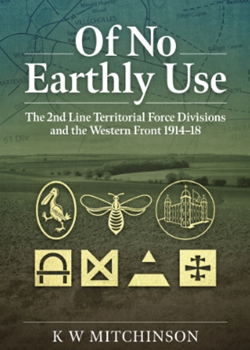Of No Earthly Use. The 2nd Line Territorial Force Divisions and the Western Front 1914–18 by K W Mitchinson
- Home
- World War I Book Reviews
- Of No Earthly Use. The 2nd Line Territorial Force Divisions and the Western Front 1914–18 by K W Mitchinson

(Helion, 2021) £29.95, paperback, 301 pages inc maps, index, notes and refs. plus 18 pages full colour photographs. ISBN 978–1–914059–95–7 Buy a copy now > https://bit.ly/3OpHctp
Since 1995, Bill Mitchinson has been producing meticulously researched books on some of the less fashionable units of the British Army in the early 20th century, especially Territorial ones. His first book, Gentlemen and Officers, remains an outstanding unit history. Bill has now turned his attention to the 2nd line Territorial divisions with the BEF, too often written off as simply second rate, producing a very fine history, concentrating chiefly on those which served abroad. 2nd line Territorial divisions, to match the pre–war established first line ones, were originally formed in 1914–15 from surplus recruits and those Territorials who had declined Foreign Service. Given the lowest priority for equipment by the War Office, employed on home defence and required to send drafts of their best men to their 1st line equivalents, they seemed to have a doubtful future, leading to questions in Parliament. Indeed, one MP described their men as ‘perfectly unfit and of no earthly use for military service’. Eventually, however, during 1916–17, seven of these 13 divisions were sent overseas: 57th, 58th, 59th, 60th, 61st, 62nd and 66th. This was not only to strengthen the BEF, but also to demonstrate to our French allies our continuing commitment to the Western Front. By this time, ‘Territorial’ was perhaps a misleading description, as the ranks of these divisions had been made up with ‘Derby men’ and conscripts, and many senior officers had been replaced with regulars.
Once in France, the seven divisions had varying introductions to the Front. The 61st met defeat when thrown into Haking’s misguided attack at Fromelles. However, the 58th was seen to do well when it successfully attacked at Bullecourt, luckily as the Germans were withdrawing after seeing off earlier assaults. The 2nd line divisions went on to fight at Third Ypres, Cambrai and then the great battles of 1918.
Bill examines, in much detail, how the divisions were established, who served in them and their training. He makes judicious assessments of their battlefield performance, with particular attention to Third Ypres, Cambrai and Kaiserschlacht. He concludes that whilst they may not have been amongst the best divisions, they certainly did not deserve their poor reputation.
This is an excellent, exhaustively researched study of unfairly neglected units, with much fascinating detail and reasoned judgements. It will be of great appeal not only to those with an interest in the individual divisions, but also in the Territorial Force generally at Passchendaele, Cambrai and the Kaiserschlacht. It is produced on Helion’s usual glossy paper, allowing excellent reproduction of the numerous photographs of the battlefields today, and taking up less room on the bookshelf! It is, perhaps a pity that there are no contemporary photographs, but high fees payable by authors to the major collections can be a disincentive. My only reservations are the occasional overuse, I feel, of modern military management jargon (attiring, indeed!); the maps could do with more detail; and the cover price.
Highly recommended.
Review by Michael Lucas
(This review first appeared in the April 2022 edition of Stand To! (No.126) The journal of The Western Front Association which is published four times a year and is sent to members in print and digital forms.)





